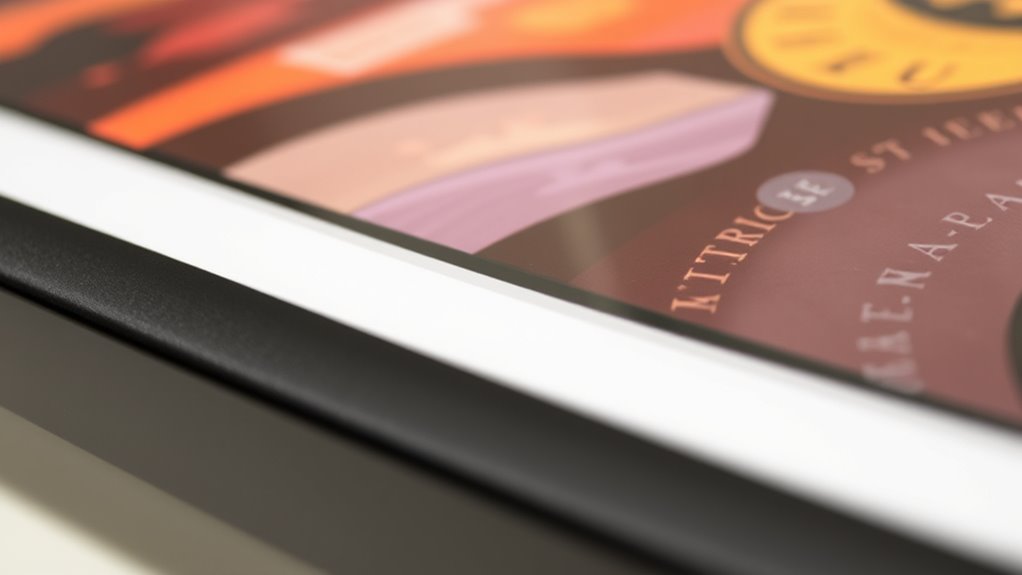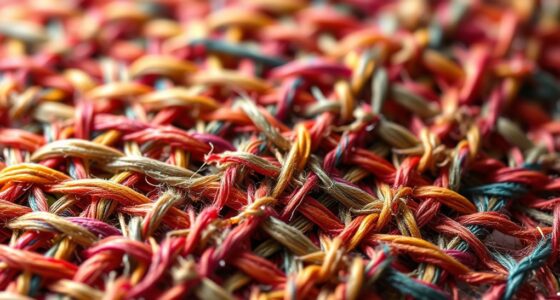Museum-quality framing means using acid-free materials to prevent yellowing and deterioration over time. It also involves UV-protective glass or acrylic to block harmful rays that fade colors and damage details. High-grade, durable frames and proper mounting techniques help avoid damage from warping or corrosion. The combination of these features guarantees your artwork stays vibrant and well-preserved for years. Keep exploring to discover how each element works together for maximum protection.
Key Takeaways
- Museum-quality framing uses acid-free materials to prevent deterioration of artwork over time.
- UV-protective glass or acrylic shields the piece from light-induced fading and color loss.
- High-grade, durable frames made from quality materials ensure stability and resistance to environmental damage.
- Conservation-grade mounting techniques avoid invasive methods, preserving the artwork’s integrity.
- Additional features like anti-glare glass and sealed environments enhance protection and viewing experience.

When it comes to preserving and showcasing artwork or valuable collectibles, adhering to museum-quality framing standards is vital. These standards ensure your pieces stay vibrant and intact over time, preventing deterioration and damage. One of the key elements is using acid-free materials. Acidic substances in traditional papers, mount boards, and backing can cause yellowing, brittleness, and deterioration of your artwork or collectibles. By choosing acid-free mats, backing boards, and mounting materials, you eliminate this risk, providing a neutral environment that helps maintain the integrity of your items. This is especially important for delicate artworks, photographs, or paper-based collectibles that can be compromised by acidity over the years. Additionally, understanding the importance of light exposure and its effects on artwork can help in making informed framing choices to further preserve your pieces.
Using acid-free materials preserves artwork and collectibles, preventing yellowing, brittleness, and deterioration over time.
UV protection is another critical aspect of museum-quality framing. Ultraviolet rays from natural or artificial light can cause fading, discoloration, and weakening of pigments and dyes in your artwork. High-quality UV-protective glass or acrylic filters block out a significant portion of harmful UV rays, preserving the original colors and details. When you select UV protection, you’re effectively shielding your pieces from the gradual effects of light exposure, which is one of the main causes of deterioration in stored or displayed art. This layer of protection is especially vital for pieces that are exposed to sunlight or intense lighting conditions, such as in galleries or homes with large windows.
In addition to these materials, museum-quality frames are typically crafted from high-grade, stable materials like hardwood or aluminum, which resist warping or corrosion. The mounting techniques also matter; conservation-grade hinging and secure, non-invasive methods prevent damage during framing or future handling. Proper sealing and the use of barrier layers further safeguard artwork from dust, pollutants, and fluctuations in humidity, all of which can accelerate deterioration.
You should also pay attention to the glass or acrylic used. Non-reflective, anti-glare options improve visibility and reduce eye strain, while ensuring the protective layer doesn’t compromise the viewing experience. When all these elements come together—acid-free materials, UV protection, quality framing, and proper sealing—you create a display that not only looks professional but stands the test of time. By following museum-quality framing standards, you’re giving your artwork or collectibles the best chance to remain pristine, vivid, and valuable for years to come.
Frequently Asked Questions
What Are the Most Common Materials Used in Museum-Quality Framing?
When choosing materials for framing, you should focus on quality. Opt for acid-free mat board to prevent damage over time, and select glazing options like UV-protective glass or acrylic to shield your artwork from light and environmental factors. These materials help preserve your piece’s integrity, ensuring it looks great long-term. Proper mat board selection and glazing are key to achieving a professional, museum-quality finish that maintains your artwork’s value.
How Does UV Protection Impact Artwork Longevity?
UV protection considerably impacts your artwork’s longevity by reducing damage caused by light exposure. UV filters block harmful ultraviolet rays that can cause fading, discoloration, and deterioration over time. By incorporating UV filters into your framing, you shield your artwork from light exposure, preserving its vibrant colors and details for years to come. This simple step helps maintain your piece’s original beauty and ensures it stays in excellent condition longer.
Can Museum-Quality Framing Be Customized for Non-Art Items?
Ever wondered if museum-quality framing can be customized for non-art items? Absolutely! You can explore various custom framing options designed specifically for non-art item preservation, such as memorabilia, photographs, or collectibles. By choosing the right materials and techniques, you guarantee these items are protected and showcased beautifully. Custom framing isn’t just for artworks—it’s a versatile solution that helps preserve and enhance the significance of any cherished non-art item.
What Is the Typical Lifespan of Museum-Grade Framing Materials?
You might wonder about the lifespan of museum-grade framing materials. Typically, if you use acid-free backing and opt for conservation framing, your display can last 50 to 100 years or more. Regularly maintaining and avoiding direct sunlight helps prolong their life. Choosing high-quality, archival materials guarantees your items stay protected and preserved for generations, making your investment in conservation framing truly worthwhile.
How Do Environmental Conditions Affect Framed Artwork Preservation?
Your artwork’s preservation hinges on climate control and air quality; neglecting these can cause irreversible damage. Extreme temperatures, humidity swings, or pollutants are like silent assassins, slowly deteriorating your pieces. By maintaining stable climate conditions and ensuring clean air, you protect your framed art from warping, fading, or mold. Proper environmental management is essential; it’s the shield that keeps your treasured artwork vibrant and intact for generations.
Conclusion
By following museum-quality framing standards, you guarantee your artwork stays protected and looks stunning for years. Did you know that proper framing can extend the lifespan of your artwork by up to 50%? That’s a compelling reason to prioritize high-quality materials and techniques. So, invest in the best framing practices, and you’ll enjoy vibrant, preserved art that not only impresses everyone but also stands the test of time. Your masterpieces deserve nothing less!









